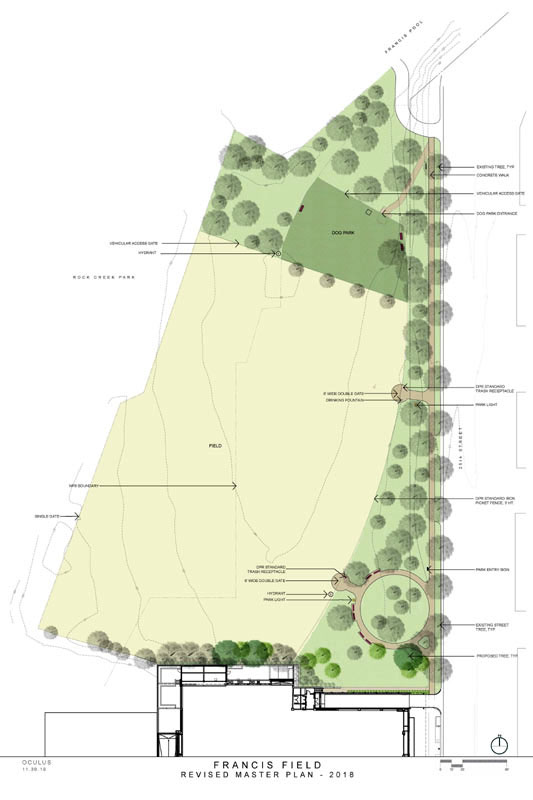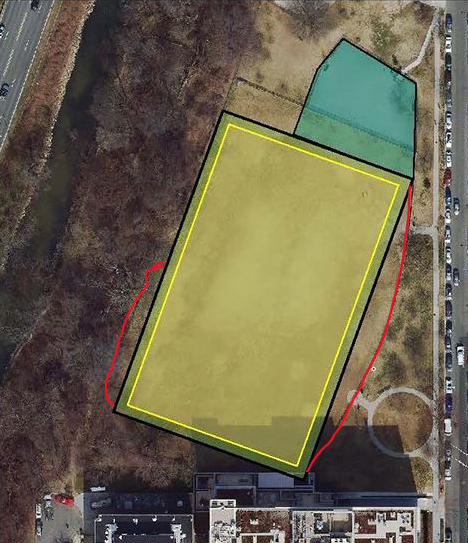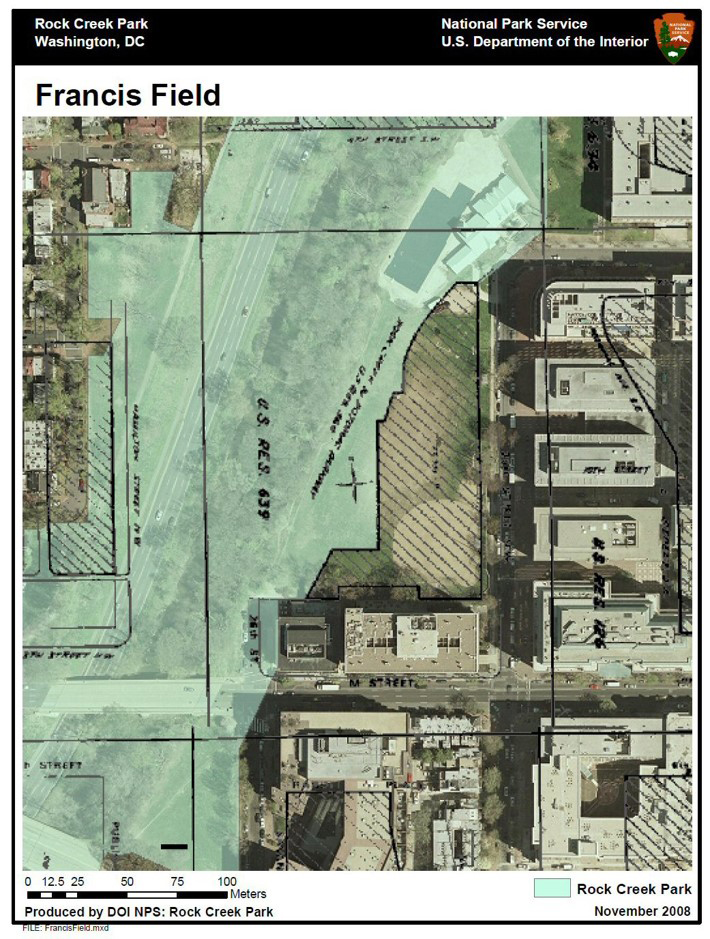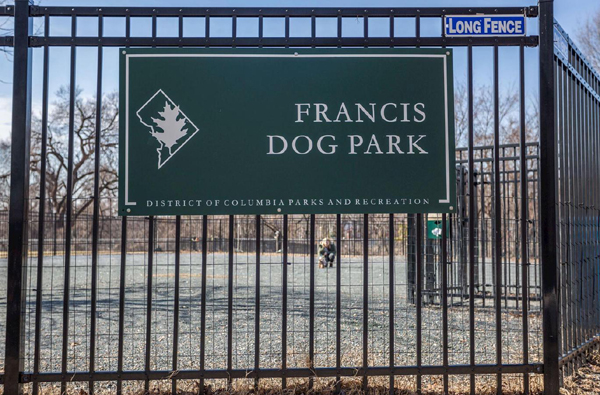Community Engagement for $3-Million Renovation of Field Begins Soon
Posted: December 12, 2022.
Informal discussions and exchanges of ideas have already begun between FFF and the District government regarding the $3-million "renovation and dog park expansion" on Francis Field that is now in the District budget.1

However, no formal meetings have yet been scheduled to begin the required Community Engagement process. (See background article.)
That series of meetings is expected to begin after January 1st, and should involve stakeholders, including dog owners, neighbors, other users of the field, and the general public.
DPR describes the purpose of the funding as: "To renovate the natural grass field and the dog park to better serve the community." Peter Nohrden, the DPR project manager and architect in charge, tells FFF that the idea is to improve the playing field for "for human community activities" and to improve the dog park in a way that will "encourage the community" to use it.
Changing the surface of the dog park from crushed stone to artificial turf is contemplated as one attraction, and the budget will allow it.
Lessons from the Previous Engagement
As shown in the architectural plan at right, Francis Field is already well-defined, with a master plan updated in 2018 to show existing conditions.
On the plan, the existing dog park is indicated in solid green, north of the athletic field, which is indicated in light yellow. (A large version of the plan is on this website in "PDF format.)
While managed and permitted by the D.C. Department of Parks and Recreation (DPR), about half of the athletic field area is owned by the National Park Service, and the field's architecture is under the aesthetic jurisdiction of the presidentially-appointed U.S. Commission of Fine Arts.2
Expanding the dog park is essentially an exercise in drawing lines on the existing plans, or on aerial photographs, like the one shown below, which was provided by DPR. It shows a regulation soccer pitch in yellow, with the existing dog park in blue—with extended space to the south. It is not an actual plan, but a dimensional sketch meant to be helpful, and is published here with DPR permission.

Francis Field's present dimensions were adopted in 2008, during the mayoral administration of Adrian Fenty, when he and his second DPR director, Clark Ray, wanted the field to become a semi-professional soccer venue surfaced with artificial turf.3
However, Ray did not understand that about one half of the athletic field was part of Rock Creek Park, which is a national park, and under the ownership of the National Park Service (NPS).4
The use of artificial turf was rejected by NPS, which also stated in a letter that DPR "did not do a thorough land record search" before "considering improvements on National Park Service property."5
No regulation soccer game has been played on Francis Field since Stoddert Soccer's three-year agreement with DPR expired in February 2012.6 Its professional-size soccer goals were removed from the field a year later.

Also complicating the dog park expansion is an NPS regulation that dogs-off-leash are not permitted on Rock Creek Park property.
During the 2008-2009 "land record" snafu, Rock Creek Park produced the diagram shown at right, to illustrate that only a part of Francis Field is under DPR land management—the diagonally-striped area, which is officially U.S. Reservation No. 639.
The rest, shown in light green, is part of U.S. Reservation No. 360, which is "Rock Creek Park and Parkway," acquired under an act of Congress, mostly from private owners, beginning in 1913.7
The striped area on the diagram was purchased much later, after the passage of the Capper-Cramton Act of 1930, which provided funds for "parkways, parks and playgrounds" during the Depression era.8

In 1971, when the District was achieving home rule, Reservation 639 was still named "Francis Recreation Center," and was one of several Capper-Cramton playgrounds transferred that year to the management of the District's new government.9
So, the entire striped area of the diagram above—more that 77,000 square feet— could today become a dog park without infringing on NPS property. However, that would leave little room for the field sports that have been played at Francis Recreation Center, or Francis Field, for at least the last 80 years or so.10
The 2009 diagram at left shows the trial shape of the potential dog park as a trapezoid in the same area north of the athletic field. This was drawn on a surveyor's plat that also showed the soccer field layout and the irregular NPS border that runs through it.
The Architectural Challenge
FFF has a partnership agreement with DPR for the next three years to improve some sections of field. We expect to be a party in the upcoming Community Engagement process. We were also a party in the 2007 Zoning Case that ordered the landscape plan and the park-like improvements for Francis Field that remain in place today.11
That process involved three stakeholder meetings, a public meeting at the West End Library, and a thirty-day comment period on the proposed plans.
Our neighborhood was struggling to become more residential then, and it did not want a semi-professional soccer venue, but the field was designed to accommodate one. Once the idea of regulation soccer—which has not been played on the field for over ten years—is put in the background, avenues to a better solution may appear.

Certainly a talented and creative architectural firm can design a dog park that has shade, greenery, landscaping, and is appealing to both humans and dogs. The success of the project will be largely determined by the choice and quality of the contractors.
FFF is on record as requesting DPR and the Department of General Services (DGS) to follow their published guidelines and March 2021 "standard operating procedures," and hear from the community BEFORE the contractors are hired.
The existing Francis Dog Park, contracted by DGS in 2015, early in the mayoral administration of Muriel Bowser, seems an example not to follow. It was not submitted, as required, to the CFA for review--and what might it have it gained if it was? The budget was $300,000, although the land on which it was built did not have to be purchased.12 It presents essentially as a fence surrounding gravel.
Dog owners in the neighborhood certainly must be heard about their needs in the Community Engagement process. They are our neighbors, and they need to take their pets out on a daily basis.
FFF does not represent the dog owners who formed a separate organization in 2018 to improve the existing Francis Dog Park, and FFF does not raise funds for that purpose. We do, however, have members who are dog owners and use the field responsibly, and we welcome others to join in this process.
Try It Yourself
While it is not a finished concept or plan, FFF has sent our partners at DPR an aspirational drawing to stimulate thinking and facilitate discussion about the project. It is shown below, in the format of a PowerPoint slide, using the 2018 master landscape plan as a base:
Aspirational scheme with natural grass area for open use—separated from athletic field.
FFF believes that the portion of the field acquired as landscape architecture be respected as such. It serves that purpose well, and should remain as natural as possible. The other half of the field was purchased later, under an act of Congress, for use as playground and recreation space.
The main athletic and sports activities for which DPR seems to have issued permits since 2012 are listed in the left column of the slide above.
FFF is on record with DPR—and in our written testimony to the District Council in support of the funding—in requesting that the athletic and physical education activities of the Francis-Stevens Education Campus, a K-through-8 public school on the same block as the field, be given priority in permitting, and that the field be maintained to be safe for elementary school play.
A copy of the FFF testimony filed in support of the funding, is on this website
A lacking feature of the field that seems most needed is a natural turf, non-athletic, but fenced-in area that would allow dogs to chase tennis balls thrown by their owners. That appears to be a regular activity for many of our neighbors. Could we devote a long, narrow part of the field as a fenced-in "Open Use" area, like the one shown on the slide above? This would not be part of the "official dog park," but rather something of an experimental alternative, inside a low, three-foot fence like the one from which the gates have been removed.
At the same time, that newly delineated area would provide an alternative to the athletic field for dog exercise. While the gates are down (see first article above) could we try an experimental area defined with wooden snow-fence and see if our neighbors who are dog owners would use it, rather than the athletic field?
The "official dog park" might be reduced in size, but made more comfortable with shade—perhaps by an arbor of vines or a pergola. If artificial turf must be used somewhere, this might be the place.
The remaining space used by the present dog park might be restored to natural turf, and landscaped in a way to provide an area more appropriate for smaller dogs and puppies.
FFF encourages our neighbors and the District government to put their heads together and make real improvements to this important civic asset.
Notes
1. For background, see article on this website, FFF Testifies in Favor of $3 Million Request for Francis Field Renovation, which also contains a link to the written testimony filed by FFF.
2.See Master Landscape Plan for Francis Field article on this website, which shows the master plan and its sub-plans, which were approved by the U.S. Commission of Fine Arts in April 2020.
3. DPR Director Ray's planning for artificial turf on Francis Field are included in DC Stoddert Soccer, "Minutes of the Meeting of the Board of Directors," January 9, 2008, Item IV, B, p. 3.
4.The first 2009 submission to the CFA is included on this website in PDF format. See District of Columbia Department of Parks and Recreation, Francis Field: Park Improvements, January 8, 2009.
5. Adrienne A. Coleman, Superintendent, Rock Creek Park, to Thomas E. Luebke, Commission of Fine Arts, February 15, 2009.
6."Memorandum of Agreement Between District of Columbia Department of Parks and Recreation and DC Stoddert Soccer," February 27, 2009, pp. 2-3; "Attachment B," p. 7. Under this agreement the soccer organization had use of the field seven days a week during eight months of the year during the three-year period.
7. The 24 lots purchased on Square 13, where Francis Field is located, and the price paid for each, are recorded in Report of the Rock Creek and Potomac Parkway Commission,(Washington, DC: Government Printing Office, 1916) p. 48.
8."National Capital Parkways," Washington Post, 16 May 1930, p. 6.
9. U.S. Reservation 639, "Francis Recreation Center," was one of 13 Capper-Cramton reservations, all named "playgrounds" or "recreation centers," that were included in a transfer of jurisdiction between the National Park Service and the District of Columbia Government, as recorded in letter from the Office of the Surveyor, Government of the District of Columbia, to the General Superintendent, Office of National Capital Parks, National Park Service, dated October 19, 1971. It was accompanied by "Transfer of Jurisdiction" plats for each. The plat for U.S. Reservation 639 showed an area of 77,353 square feet.
10. "Francis Recreation Center" was established at least by 1938, when it was part of the District government's segregated school and recreation system. Francis Pool and Francis Junior High School, located on N Street between 24th and 25th Streets, were both opened in 1928 as separate-but-equal facilities for the non-white population. The pool and school formed the nucleus, and the school auditorium and gym, as well as the near-by tennis courts and outdoor basketball court, were all considered part of the "Francis Recreation Center." See ""Attractiveness is Playground Problem of D.C.," The Evening Star (Washington, DC), 05 Sep 1938, p. 13.
11.District of Columbia Zoning Commission, ZC Order No. 06-35, July 9, 2007, p.8. This is the order for a Planned Unit Development allowing the alteration of three office buildings at 1227-1231 25th Street NW, commonly referred to as the BNA buildings. PDF format. See pages 15 and 16 for Francis Field improvements ordered.
12. The $300,000 budget for Francis Dog Park is stated on the DGS website: https://dgs.dc.gov/page/dog-park-francis [Accessed 09 Dec 2022]
